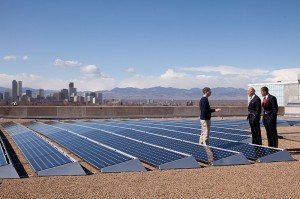 In 2014, the U.S. residential solar industry installed 1,231 MW of capacity and installation costs fell 10 percent. While lower prices made onsite solar energy more affordable and accessible for many Americans, the upfront costs still make solar installation out of reach to low-income communities that could benefit from alternative sources of energy.
In 2014, the U.S. residential solar industry installed 1,231 MW of capacity and installation costs fell 10 percent. While lower prices made onsite solar energy more affordable and accessible for many Americans, the upfront costs still make solar installation out of reach to low-income communities that could benefit from alternative sources of energy.
Over the past few years, governments at every level have been instituting programs that support low-income access to solar energy. In 2013, California extended two provisions of the California Solar Initiative, the Single-Family Affordable Solar Homes (SASH) and Multi-Family Affordable Solar Homes (MASH) programs, by providing an additional $108 million for 50 MW of solar PV installations. This past summer, the White House announced its own initiative that supports state-run community and low-income solar programs. The initiative: (1) increases the preexisting goal from 100 MW to 300 MW of solar capacity on federally subsidized housing by 2020, (2) leverages $520 million through public-private partnerships, and (3) supports employment opportunities in low-income communities via the solar industry.
Supporters of these initiatives say savings on electricity bills more than make up for the cost of switching to solar. According to Clean Power Research, on average an individual who installs solar power in the U.S. could save $84 per month on their electricity bill, or up to of $20,000 over 20 years. Rep. Elijah Cummings (D-MD 7th District), whose Baltimore district is home to a pilot project under the White House initiative, stated even a “difference in a monthly bill of $10 or $15 means a lot to the people who live on my block.”
There are concerns, however, that these initiatives could expose low-income homeowners to greater financial risk, especially if people have to take out large instant payday loans that may be difficult to repay, or if solar installations present problems when people sell their houses. Some also questions whether low-income communities would receive greater economic benefit from other energy initiatives, such as deregulation, than from access to solar.
The programs should be increased. Reducing monthly expenses in low income areas is always a win. I understand the financial risk if they have to take on a PPA. As… Read more »
The way to help low income communities is to make energy cheaper, without subsidies. Colorado policies aimed at shutting down coal plants led to soaring electricity costs in low income… Read more »
Below is an op-ed on California’s proposed state fee and solar savings that I recently co-authored with Jon Wellinghoff, the former chairman of the Federal Energy Regulation Commission and Nevada’s… Read more »
The real question should be about identifying the right metrics based on the ultimate goals of the policy. If the goal is to cut carbon, what is the most cost-effective… Read more »
On-bill financing – on trial in CA and being considered in 11 other States – is a game- changer, which has huge impact for lower income who mostly rent as… Read more »